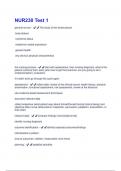NUR230 Test 1
general survey - ✔️✔️The study of the whole person
body stature
nutritional status
verbal/non-verbal expression
general health
any obvious physical characteristics
the nursing process - ✔️✔️start with assessment, then nursing diagnosis, what is the
patient outcome that I want, plan how to get that outcome, are you going to do it
(implementation), evaluation
if it didn't work go through the cycle again
assessment - ✔️✔️collect data: review of the clinical record, health history, physical
examination, functional assessment, risk assessment, review of the literature
use evidence-based assessment techniques
document relevant data
collect subjective (what patient says about himself/herself during history taking) and
objective data (nurse observations: inspection, percussion, palpation, auscultation--in
that order)
interpret data - ✔️✔️compare findings (normal/abnormal)
identify nursing diagnosis
outcome identification - ✔️✔️identify expected outcomes/findings
individualize to patient
ensure outcomes: realistic, measurable, time frame
planning - ✔️✔️establish priorities
,develop outcomes
identify interventions
document plan of care
set times for outcomes
integrate evidence-based trends and research
implementation - ✔️✔️implement interventions in a safe and timely manner
use evidence-based interventions
collaboration with colleagues
use community resources
coordinate care delivery
provide health teaching and health promotion
document care/implementation and any modification
evaluation - ✔️✔️compare established outcomes with actual outcomes
progress toward outcomes
conduct systematic, ongoing criterion-based evaluation
include patient and significant others
use ongoing assessment to revise diagnoses, outcomes, pain
disseminate results to patient and family
identify any roadblocks
modify plan
document evaluation of plan of care
evidence-based practice (EBP) - ✔️✔️"Systematic approach to practice that
emphasizes the use of best evidence in combination with the clinician's experience, as
, well as the patient preferences and values, to make decisions about care and
treatment."
Accurate assessment guides you through application of the nursing process as you
provide care
Inaccurate assessment could lead to an incorrect nursing diagnosis, interventions, or
outcomes (your plan may be ineffective/inaccurate, incomplete assessments could lead
to selection of inappropriate interventions) - ✔️✔️Why is thorough assessment
necessary?
comprehensive (admission assessment) - ✔️✔️includes health history and physical
exam
enables practitioner to have complete picture of the patients health status
episodic/focused (shift assessment) - ✔️✔️when you're leaving and someone is taking
your shift
emergency assessment - ✔️✔️focuses on "ABC'c" (airway, breathing, circulation)
follow-up assessment - ✔️✔️example: pain score after treatment of pain (after
treatment)
subjective and objective data - ✔️✔️What are the two types of patient data?
subjective data - ✔️✔️What the individual tells you in the interview
What the person says
Information from family members
Examples: family history, past medical history, cultural & spiritual, development,
functional, mental status, pain, nutritional
objective data - ✔️✔️What you, the nurse, observe, examine, or measure
Also includes data from medical testing, assessments of other healthcare professionals
Examples: general survey/observations, vital signs, head-to-toe assessment of each
system
inspection, palpation, percussion, ausculation - ✔️✔️what are the assessment
techniques?




